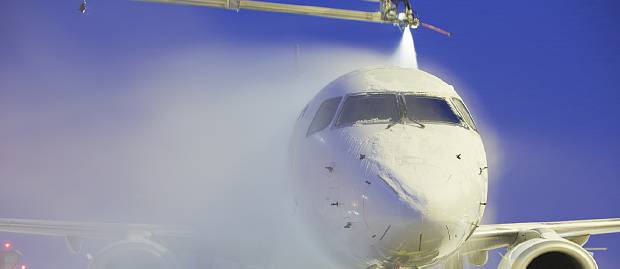Aircraft Deicing Fluids companies, manufacturers and suppliers in chennai Tamilnadu india
Aircraft Deicing Fluids companies, manufacturers and suppliers in india.aircraft deicing fluid manufacturers, aircraft deicing fluid suppliers, aircraft deicing fluid factory, india manufacturers, indian suppliers.
Deicing fluid, a mixture of a chemical called glycol and water, is generally heated and sprayed under pressure to remove ice and snow on the aircraft. While it removes ice and snow, deicing fluid has a limited ability to prevent further ice from forming.
Ground deicing of aircraft is commonly performed in both commercial and general aviation. The fluids used in this operation are called deicing or anti-icing fluids. The abbreviations ADF (Aircraft Deicing Fluid) or AAF (Aircraft Anti-icing Fluid) are commonly used.
Deicing fluids come in a variety of types, and are typically composed of ethylene glycol (EG) or propylene glycol (PG), along with other ingredients such as thickening agents, surfactants (wetting agents), corrosion inhibitors, and colored, UV-sensitive dye. Propylene glycol-based fluid is more common due to the fact that it is less toxic than ethylene glycol.
Deicing an aircraft during a snow event.
Deicing fluids come in a variety of types, and are typically composed of ethylene glycol (EG) or propylene glycol (PG), along with other ingredients such as thickening agents, surfactants (wetting agents), corrosion inhibitors, and colored, UV-sensitive dye. Propylene glycol-based fluid is more common due to the fact that it is less toxic than ethylene glycol.
SAE International (formerly known as the Society of Automotive Engineers) publishes standards (SAE AMS 1428 and AMS 1424) for four different types of aviation deicing fluids:
Type I fluids have a low viscosity, and are considered "unthickened". They provide only short term protection because they quickly flow off surfaces after use. They are typically sprayed on hot (130–180 °F, 55–80 °C) at high pressure to remove snow, ice, and frost. Usually they are dyed orange to aid in identification and application.
Type II fluids are pseudoplastic, which means they contain a polymeric thickening agent to prevent their immediate flow off aircraft surfaces. Typically the fluid film will remain in place until the aircraft attains 100 knots (190 km/h) or so, at which point the viscosity breaks down due to shear stress. The high speeds required for viscosity breakdown means that this type of fluid is useful only for larger aircraft. The use of Type II fluids is diminishing in favour of Type IV. Type II fluids are generally light yellow in color.
Type III fluids can be thought of as a compromise between Type I and Type II fluids. They are intended for use on slower aircraft, with a rotation speed of less than 100 knots. Type III fluids are generally light yellow in color.
Type IV fluids meet the same AMS standards as Type II fluids, but they provide a longer holdover time. They are typically dyed green to aid in the application of a consistent layer of fluid.
The International Organization for Standardization publishes equivalent standards (ISO 11074 and ISO 11078), defining the same four types.
Deicing fluids containing thickeners (Types II, III, and IV) are also known as anti-icing fluids, because they are used primarily to prevent icing from re-occurring after an initial deicing with a Type I fluid.
Chemical composition
The main component of deicing fluid is a freezing point depressant (FPD), usually propylene glycol or ethylene glycol. Other ingredients vary depending on the manufacturer, but the exact composition of a particular brand of fluid is generally held as confidential proprietary information.
Based on chemical analysis, the U.S. Environmental Protection Agency has identified five main classes of additives widely used among manufacturers:
Benzotriazole and methyl-substituted benzotriazole, used as corrosion inhibitor/flame retardants to reduce flammability resulting from the corrosion of metal components carrying a direct current.
Alkylphenol and alkylphenol ethoxylates, nonionic surfactants used to reduce surface tension.
Triethanolamine, used as a pH buffer.
High molecular weight, nonlinear polymers, used to increase viscoelasticity.
Colored dyes, such as azo, xanthene, triphenyl methane, and anthroquinone, used to aid in identification.

